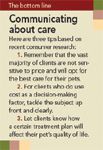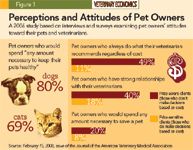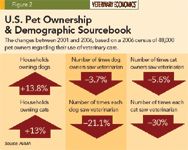Delving into clients' minds
Studies show the number of visits pet owners make to their veterinarian is declining.
People love their pets. People also love their veterinarians. That's the good news from a batch of recent studies designed to tease out rare information on pet owners' perceptions of their veterinarians. However, the studies also show a disturbing trend. The number of visits these pet lovers make to their beloved veterinarian is declining. Love isn't supposed to be like that.

The bottom line
The bonds are strong
Several major studies have appeared recently that nose into a deeper understanding of two bonds—the bond between people and their pets and the bond between people and their veterinarians. Together these studies have exponentially increased collective understanding of pet owners' perceptions about the veterinary profession.

Illustration by Marci Roth
> The Perceptions and Attitudes of Pet Owners. In 2006, a major study of pet owner perceptions was undertaken by a consortium of industry leaders and veterinary organizations. BNResearch conducted the four-phase survey, looking for clues to attitudes about veterinary care. The findings: Most owners said they would pay whatever was necessary for the health of their pet.
> U.S. Pet Ownership and Demographics Sourcebook. The AVMA completed a large-scale census of pet owners in 2006, examining 48,000 households' use of veterinary care. The big news: While more dogs and cats joined families, canine veterinarian visits declined 3.7 percent between 2001 and 2006. Feline declines were more precipitous: cat visits fell 5.6 percent.
> A Focus Group Study of the Perceptions of Monetary Aspects of Veterinary Care. Also in 2006, a group of Canadian researchers used qualitative techniques to study both pet owners' and veterinarians' perceptions of the financial aspects of veterinary care. The researchers utilized focus groups to peer into this sensitive area. They found that pet owners wanted to know about cost up front and in the context of what the treatment would mean for their pets.
The results of all three studies provide a much richer understanding of what happens between the veterinarian and the pet owner in the exam room, and practitioners have much to be encouraged by. For one, the news about client loyalty was positive. The Perceptions and Attitudes study reported that seven in 10 pet owners said they would stay with their veterinarian even if another practice had lower prices. Two of three said they would stay with their present veterinarian even if they moved 45 minutes away.

Figure 1
So why fewer visits?
Despite these rich new veins of information, the reasons for why visits are declining aren't necessarily clear.
It may be tempting to blame rising costs. Average transaction fees, according to Howard Rubin, former CEO of the National Commission on Veterinary Economic Issues (NCVEI), rose more than 10 percent between 2004 and 2006; examination fees increased 16 percent. At first glance this might seem to reflect what veterinarians have long feared: That people won't pay for quality care after all. That they don't respect veterinarians' expertise. That because they pay only co-pays for their own doctor visits, they have no idea how much medical care really costs.

Figure 2
The problem is that the research doesn't appear to support these deep-seated fears. The investigators who reported the Perceptions and Attitudes study in the February 15 issue of JAVMA are confident that cost is not the most important factor in pet owner decisions. In fact, they suggest, cost is usually not a factor at all. Only 19 percent of the respondents appeared to be willing to make decisions based on cost (these pet owners were labeled "price-sensitive" by the researchers), while eight of 10 respondents said that neither cost nor inconvenience would drive their decisions about veterinary care (these clients were found to be either "price-unconscious," giving no thought to the cost of care, or "price-conscious," with an awareness of cost but not willing to let it dictate treatment—because these two groups made similar decisions, they were collectively labeled "price-aware"). "In the relationship between veterinarians and clients, it turns out the one who is most price-sensitive is the veterinarian," says AVMA marketing director James Flanigan.
Of course, it's possible that the decline in visits is entirely the work of that 19 percent cost-sensitive group. However, two-thirds of those folks still vowed they would pay anything to keep their pet healthy.

Figure 3
So while the research doesn't prove that cost is not the reason for declining visits, it strongly suggests that the profession look elsewhere for answers.
Fewer perceived reasons to visit?
Flanigan believes that changing vaccine protocols may be an important factor. "Three key utilizations of the veterinary practice have been vaccination, examination, and the purchase of medicines," he says. The number of cat owners who reported receiving vaccinations during their last visit dropped almost 10 percent, according to the AVMA study, evidence of the effect of longer protocols. With the study also reporting a decline in the number of people who buy medications from veterinarians, two of the traditional motivations for clinic visits are fading, he says.
"Based on the data, it's far more likely, at least for cats, that the decline in visits is related to the lack of a trigger to remind pet owners they need to see the veterinarian every year," he says. "As new protocols continue to be adopted, we need to find a way to replace traditional triggers with something else. Veterinarians need to be recognized for what they know, not just as people who sell pills and give shots."
What veterinarians know comes across most forcefully in the exam room. But here's the shocker: Clients rarely realize when their pet is being examined. The Perceptions and Attitudes study reports that fewer than one in 10 respondents mentioned that their veterinarian performed an exam when the pet visited the clinic for another reason—even though an exam was most likely performed on every pet. The other nine, says Dr. Karen E. Felsted, CPA, CVPM, a consultant with Gatto McFerson in Santa Monica, Calif., may have assumed the veterinarian was just soothing their pet, stroking her fur, keeping her calm for a shot.
"The exam needs not only to be performed but also articulated," says Dr. Felsted, a Veterinary Economics Editorial Advisory Board member. "The veterinarian needs to be telling the client, 'Fluffy's eyes are clear; I don't see any infection. I'm looking at her gums and I see some tartar buildup. Now I'm looking at her ears, listening to her heart ... ' It doesn't take two minutes of extra time, but it communicates value. Just doing the exam isn't enough."
This isn't necessarily news to veterinarians; many in the profession have seen which way the vaccine wind is blowing and are trying to adjust. But for all their efforts, Dr. Felsted says, clients are persisting in seeing visits as vaccine visits. "Pets need to be seen once a year whether or not they're getting vaccinations," she says. "Cats are the worst statistic of all. They're not getting even remotely the amount of care they need."
Here's another possible reason cats are seen so rarely (about half as often as dogs, according to the Perceptions and Attitudes study): A dangerously high number of cat owners don't see the necessity of annual veterinary care. Eleven percent of cat owners told the Perceptions and Attitudes study surveyors that cats don't get sick, and another 7 percent said cats take care of themselves. "I believe that when people actually get to the practice, the vast majority of clients are not price-sensitive," Dr. Felsted says. "But I wonder if there's an increased sensitivity about going to the veterinarian in the first place. We're obviously not communicating the need very well."
Which brings the discussion back around to the thorny issue of money versus care. Despite all the good feelings out there about veterinarians, and despite the Perceptions and Attitudes study indicating an absence of price-sensitivity on the part of most clients, other research shows that at least a handful of pet owners believe veterinarians are motivated more by money than patients' needs.
The 2006 focus group study reported in the November 15, 2007, issue of JAVMA found that "an atmosphere of suspicion" existed among certain clients regarding veterinarians' motives. Interestingly, those suspicions were directed at the profession as a whole, not at the participants' own veterinarians. Here's one pet owner's response: "Veterinarians have to be very careful that they don't give people the impression that they're keeping you coming back."
In fact, most veterinarians do want to keep clients coming back—for at least one physical examination a year. The researchers suggested that doctors tackle these suspicions directly.
Communication builds compliance
Cindy Adams, MSW, PhD, one of the authors of the focus group study and an expert in veterinary communications, emphasizes that the way practitioners offer their treatment recommendations affects clients' perceptions. She wants doctors to change the way they make their recommendations—rather than heaving them like a shot put, she wants them tossed like a Frisbee.
"A message that's laden with jargon and without a check to find out what the client wants to know lands with a plunk," she says. Throwing a Frisbee requires interaction and collaboration. "That approach gets to shared decision making. And shared decision making is a predictor of compliance."
While it's always good to build basic communication skills, Adams cautions doctors against working from scripts, which she says are not flexible enough to respond to the breadth and depth of the clientele. "There's a huge variability in clients' relationships with their animals," she says. "You need to know what their goals and aspirations are for this relationship. Ask them what they think needs to happen. It's a dialogue, a conversation. A veterinarian who can determine a client's interests may be able to shift that client from an infrequent visitor to an annual or every-six-months visitor."
Adams says this dialogue can even give people permission to forge stronger relationships with their pets. The goal is for both the veterinarian and the client to be committed to the patient. And, she cautions, the conversation has to address money issues up front.
Focus group pet owners said they wanted the financial conversation up front in the exam room and wanted cost placed in a "meaningful" context. "They want to know how the money they spend is going to affect what they're invested in," Adams says. The study suggests that clients want the veterinarian to initiate the discussion of cost and to place it in the context of "a reasonable prognosis" for their pet. In other words, clients are not as interested in knowing the medically accepted protocol as they are in knowing what their pet's quality of life will be after treatment.
While the AVMA's Flanigan thinks the best advice from the Perceptions and Attitudes study is that veterinarians "need to make the best medical recommendation to clients no matter how sensitive to cost they think they will be," he doesn't believe this conflicts with what Adams' focus group participants said they wanted. In fact, he would categorize those respondents as "price-sensitive," which calls for a different approach.
"For this group, the doctor will weigh a number of issues, from quality of life to prognosis," he says. "The focus group feedback tells doctors to make all those considerations plain in understandable language, while at the same time being transparent about the relative costs of each option. You still make the best medical recommendation."
Finding a way to communicate to all clients, whether they're hypersensitive to cost or utterly oblivious, deeply bonded to their pet or relatively indifferent, is critical to both compliance and increasing the number of annual visits—essentially, to building the bond between client and pet and yourself and client. Those bonds are, of course, why most of you got into this business.
Veterinary Economics special assignments editor John Lofflin is a freelance writer in Kansas City, Mo. He teaches journalism at Park University in Parkville, Mo. Send your comments to ve@advanstar.com